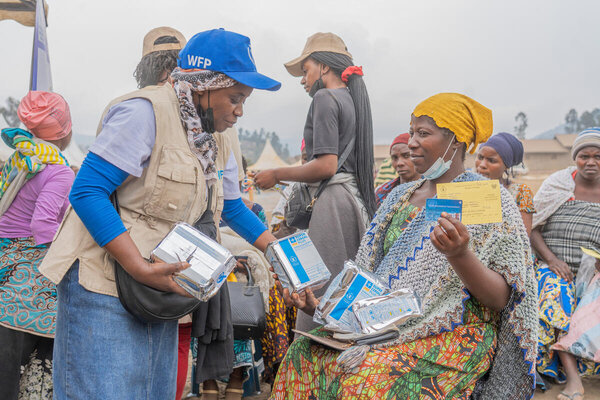According to the latest Integrated Food Security Phase Classification (IPC) analysis, 26.6 million people nationwide are projected to face crisis levels of food insecurity or worse (IPC Phase 3 and above) by early 2026, including 3.9 million people in emergency levels of hunger (IPC Phase 4). This is an increase from the current figures of 24.8 million and 3.2 million respectively.
Food insecurity dire in the eastern provinces
The hunger crisis is most severe in the conflict-affected eastern provinces of North Kivu, South Kivu, Ituri, and Tanganyika. Ongoing violence, population displacement, and limited humanitarian access continue to worsen food insecurity in these areas. By January 2026, more than 10 million people in these four provinces - about one-third of the local population - are expected to face crisis levels of food insecurity or worse, struggling daily to meet their basic food needs. Among them, 3 million people are already experiencing emergency levels of hunger, representing 75 percent of all those in such conditions nationwide and an increase of 700,000 since March 2025.
Malnutrition among children remains a concern in the eastern provinces of Ituri, South Kivu, and Tanganyika, where poor dietary diversity, limited access to healthcare, and recurring disease outbreaks continue to exacerbate the situation.
Beyond these regions, malnutrition is widespread across the country. Nearly half of all children under five - approximately 3.2 million - are stunted due to chronic undernutrition, severely impacting their growth and development. An ongoing IPC Acute Malnutrition (AMN) analysis is currently underway to better understand the severity.
FAO Operations in DRC
"Emergency agricultural assistance is one of the most cost-effective ways to meet urgent humanitarian needs," said Athman Mravili, Representative ad interim for FAO in DRC. "By equipping vulnerable and displaced families with the tools to grow their own food and earn income, this support not only addresses immediate hunger but also fosters resilience. Importantly, communities themselves consistently identify agricultural assistance as a top priority in times of crisis."
But, by the end of August 2025, FAO had assisted just 217,000 people out of the 3.6 million planned, due to a massive funding gap. For 2026, FAO requires US$127 million to scale up support to assist around 2.4 million people.
WFP Operations in DRC
WFP continues to focus its response in the eastern provinces, but growing needs threaten to overwhelm already stretched resources. In 2025, WFP had planned to support 2.3 million people, but assistance has now been reduced to 600,000 people due to funding shortfalls, with a total pipeline break anticipated by February 2026. WFP's country operation currently faces a US$349 million funding gap through April 2026.
"We are working tirelessly with the government and the humanitarian community despite shrinking resources for this neglected crisis," said Cynthia Jones, WFP's Acting Country Director and Representative in DRC. "The latest IPC figures make one thing clear: the eastern DRC's food crisis is escalating. Without urgent resources and action, millions of lives are at risk, and regional stability will suffer. The time to act is now - before the cost becomes irreversible."
Notes:
High levels of acute food insecurity (or acute hunger) refer to populations in IPC Phase 3 or higher. Populations classified in IPC Phase 3 (crisis) and Phase 4 (emergency) require urgent action to save lives, reduce food consumption gaps, and protect livelihoods. In Phase 3, families may resort to less preferred or less nutritious foods, skip meals, or sell productive assets to afford food. In Phase 4, they may adopt more extreme coping strategies such as selling their last livestock or resorting to begging.
Broadcast quality footage available here .
High-resolution photos available here .
About FAO
The Food and Agriculture Organization of the United Nations (FAO) is a specialized agency leading international efforts to defeat hunger. FAO aims to transform agrifood systems to be more efficient, inclusive, resilient, and sustainable-for better production, better nutrition, a better environment, and a better life, leaving no one behind. FAO's goal is to achieve food security for all and ensure people have regular access to enough high-quality food to lead active, healthy lives.







